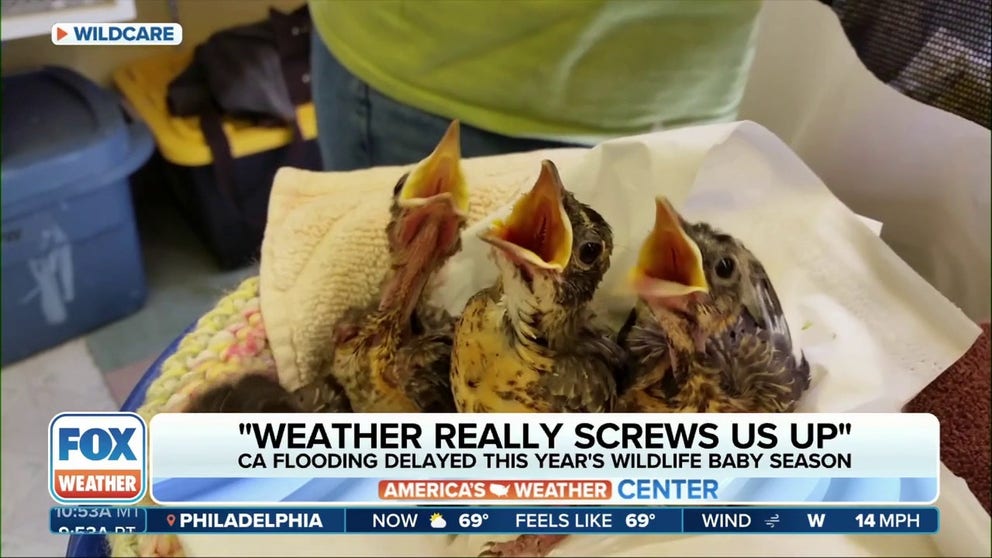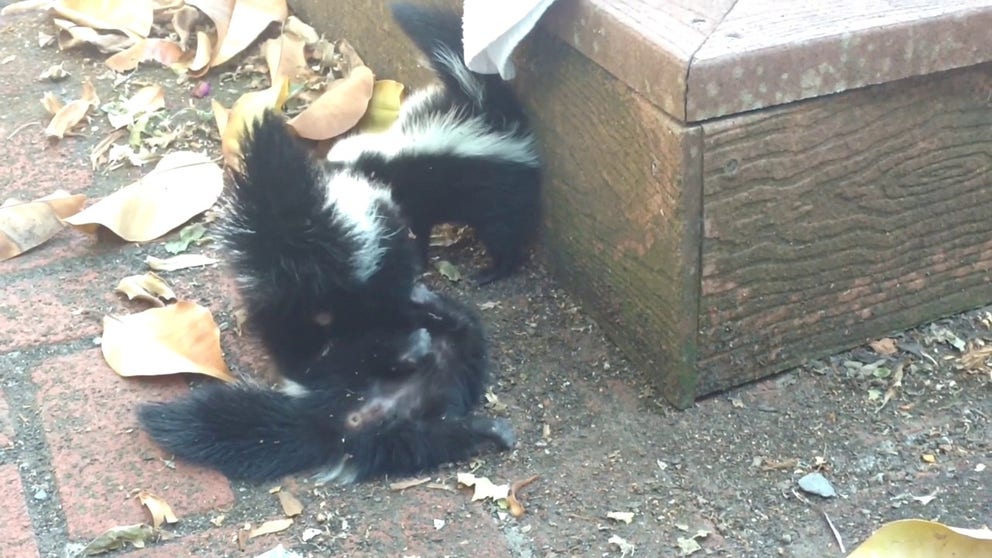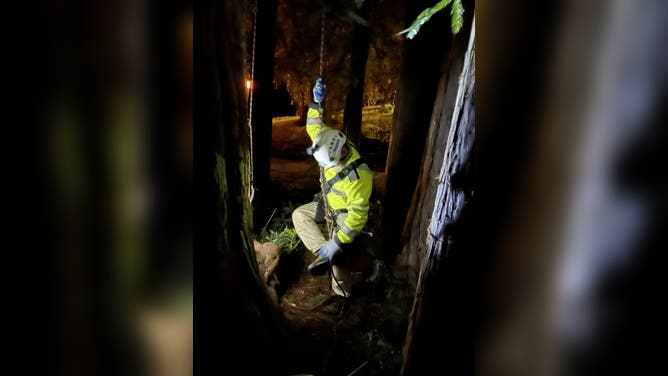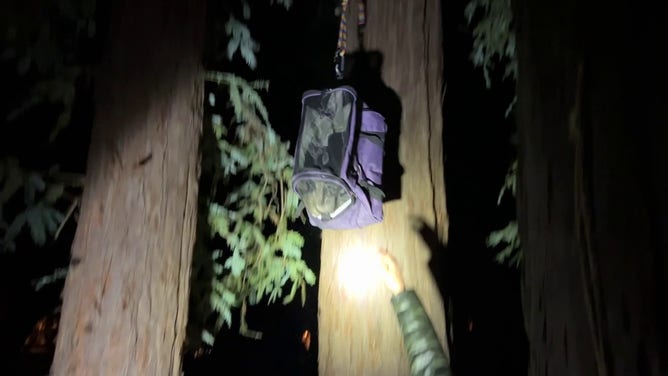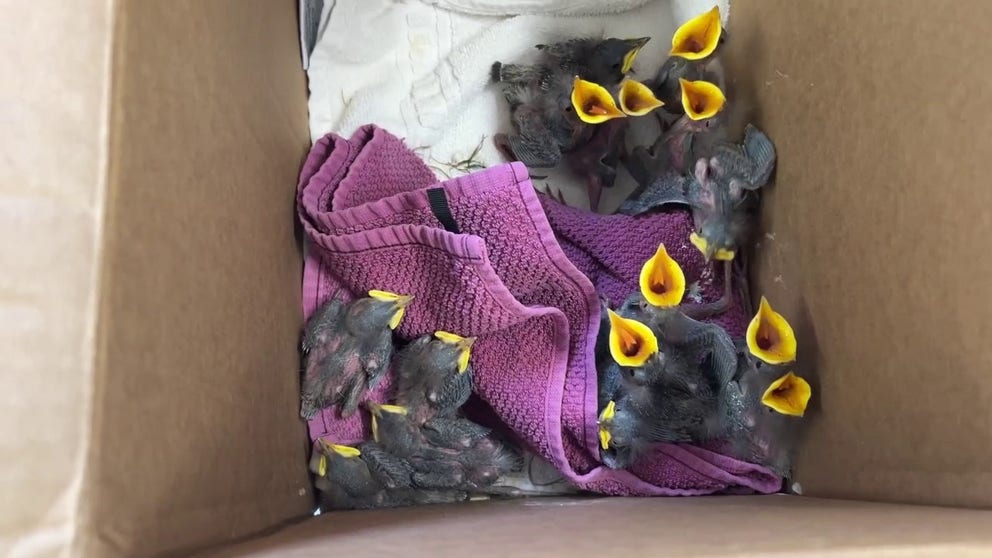Video: Wildlife baby season rescues in full swing after series of atmospheric river storms
Baby season, when wildlife bring their young into the world, is a crazy time for wildlife rescues, especially when weather is involved. Winter weather lingered though spring in California, putting many animals' babies in jeopardy.
Atmospheric river rains delay wildlife baby season in California
Melanie Piazza, director of Animal Care at Wildcare, explains how the organization has been busy responding to animals this spring. The rains and flooding from multiple atmospheric rivers have delayed this year's baby season.
SAN RAFAEL, Calif. – It is all hands on deck and volunteers around the clock this baby season at the WildCare Wildlife Hospital and Rehabilitation Center in California as lingering winter storms and spring yard cleaning disrupt nests.
"So weather really screws us up," Animal Care Director Melanie Piazza explained.
"When there are weather events, it can double or triple our patient intakes, so you get a really windy day or a windy storm and a squirrel nest that might not have been built the best, blows down and all the babies come down," Piazza continued. "Same with birds, you know, really windy day or very rainy day. And the babies in the nest are blown out of the tree. That is typical."
WildCare suspects late season storms killed early season babies
Baby season is running about a month late this year after a series of atmospheric river storms took a toll on wildlife into spring. Between March and August, WildCare sees 60-70% of its 3,500 patients every year. Last Thursday, baby season just launched when the hospital took in 34 patients, of which 15 were starlings from the same nest. In December, staff may see one or no intakes per day.

People bring in animals that can't fend for themselves, like these baby skunks, if there is no sign of the parents.
(WildCare / FOX Weather)
Piazza said she saw an uptick in patients during the storms but then no huge influx of babies until last week.
"Especially last year, we had that really big band of storms coming through over and over and over again. Pushed our baby season start out by almost a full month," said Piazza, who is seeing the same phenomenon this year. "And so our theory on that is a lot of babies died. If their nest failed, they just failed. And because the weather was so bad for so many days, people didn't go outside and find them."
GRUMPY CAT SHOWS LITTLE GRATITUDE AFTER RESCUE FOR TIGHT SQUEEZE
Rescued baby skunks learning life skills at the rescue
These are three of five baby skunks rescued from a highway on-ramp recently. Here they are play-fighting at WildCare, part of the life-lessons they must learn before being released into the wild. About halfway through, one baby tries to charge with tail lifted but isn't coordinated enough yet and falls over.
The general public brings in about 80% of patients. WildCare is one of the few rescues that takes non-native animals.
Rehoming great horned owlets
She and a team just re-homed a great horned owlet, then a group of three, that fell victim to the tropical-storm-force winds from a late-season, mid-April storm. The video above shows one of the youngsters that will eventually be nicknamed a "tiger of the sky" for its hunting prowess, getting a little help from Piazza. She is hand-feeding it chunks of mice to make the bird strong and able to survive entry back into the wild.
WATCH: FIREFIGHTERS RESCUE CALIFORNIA FARM ANIMALS FROM FEET OF MUD
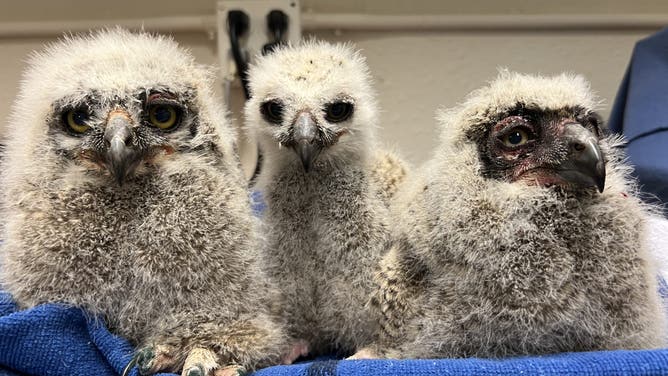
Three owls blown out of the nest by a mid-April windstorm.
(WildCare / FOX Weather)
She said that the great horned owls don't build their own nests, but move into other animals' abandoned nests.
"Because they're old, abandoned, a lot of times they're not very structurally sound. And so what happened with these babies is that we had a windstorm event, and the nest already wasn't doing well and half of it collapsed," she said. "And so two babies fell out."
One baby didn't survive the 40-foot fall. But she mobilized the Raptor Reunite Team for the others. First, she stabilized the birds and made sure they were not injured. Then, she sent a rescuer up the tree to retrieve one baby that did not fall from the nest before the nest storm with winds and freezing rain. Four to five days later, it was up to the parents to raise the little one again.
TENSE RESCUE OF GREAT HORNED OWL TANGLED IN BARBED WIRE

The set of three owlets placed in the new nest.
(WildCare / FOX Weather)
"We have a team of volunteers that go out and scout the location sites of where the baby hawks and owls are found and look for the nests, look to see if her parents are still there," Piazza said. "And then, if we can locate that, then we talk to our arborists, and our volunteer arborist will go out and set up the rope system and climb up, to get the babies back in the nest."
These nests required replacing. The series of photos below show the monumental efforts the team made to reunite the family. Photos are of the single owl and the two owls being reunited.
"And then we hoisted the babies up, placed them in the new basket nest, and mom and dad were there hooting and dive-bombing him (arborist) the whole time," Piazza said. "It's a thankless job for sure. And so our scouting volunteers have gone back the last two nights and have recorded mom and dad both still attending the nest in the new basket."
Mom and dad are best at raising their babies
She explained that parents rejecting their young because they smell like humans is generally a wives' tale. Parents abandoning a nest or healthy youngster is incredibly rare.
"We are good at what we do," she said, but mom and dad are the best. So, every animal that comes in is rehabilitated with a minimum of human interaction so that it can be raised and trained by its own wild parents.
Babies that are orphaned or hurt and need more time at the hospital actually learn life skills from the staff and volunteers. They go to great lengths to ensure that the animals do not get used to humans.
MINNESOTA BIOLOGISTS RESCUE HIBERNATING BLACK BEAR TRAPPED BY ICE, SNOW
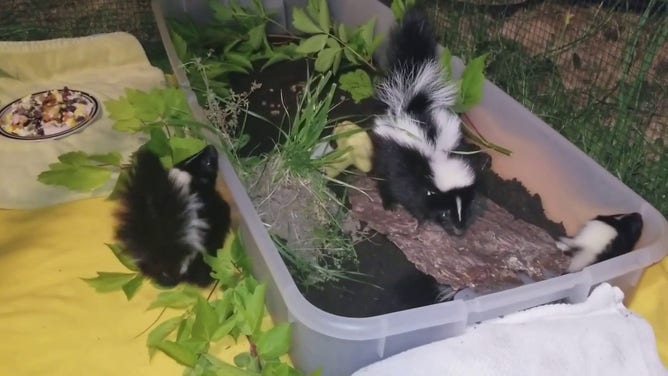
Staff and volunteers teach baby skunks to forage by burying dead insects and fish in containers on the ground.
(WildCare / FOX Weather)
"Like, when we're raising a baby bobcat, those guys, they can habituate incredibly easily. And obviously, if you have a bobcat who's comfortable with people, we would have failed. And you can't release them because you don't want them going up to humans in the wild," Piazza continued. "So we wear ghillie (camoflauge) suits, and hide ourselves. We actually have to cover ourselves, and it's really not fun, but with the straw that they urinate in, you rub that on the ghillie suit so that you smell like a bobcat and not a human."
There is no naming or cuddling the animals and no talking to them. Staff and volunteers hide behind a taxidermied spotted owl when feeding the owlets. When it is time, they send the owl to "mouse school," an aviary where staff release live mice, so the owl can learn to hunt.
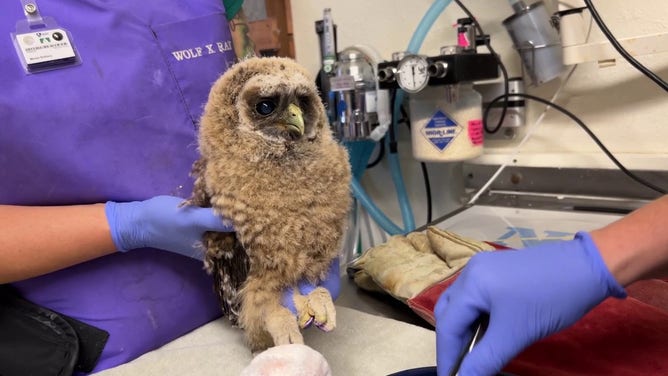
A near threatened spotted owl at WildCare.
(WildCare / FOX Weather)
"So we get them to the point where they can learn how to fly and find their own food. And then once they are able to do that and eat on their own and have the skills they need to survive, they're released back into the wild," she said. "And so that takes weeks or months, depending on the species."
The 15 starlings that kicked off baby season will need to learn how to hunt insects from an aviary because their nest was obliterated. Crews clearing trees for wildfire abatement took down the section of trunk that concealed the nest.
15 starlings rescued from nest felled by wildfire abatement
To kick off baby season, a rescuer brought in 15 baby starlings. Fire crews cut down part of a tree for wildfire abatement then realized these hungry guys were in a nest inside the tree.
In her 22 years at WildCare, she has seen about 200 different species of animal, from rattlesnakes, songbirds and water birds to mountain lions.
"What we're doing is fixing the wrongs that were done to these wild animals. And we are trying to give them a second chance at life in the wild," she said. "So whether it's a pigeon or (rare) spotted owl, we're going to do the same amount of work, or medical care, provide the same level of care, that any of these patients need because it's the right thing to do."
What to do if you think wildlife is in danger
She has a few tips for anyone who finds an animal in danger, injured or apparently without parents.
"If you can approach and have contact with, pick up a wild animal, something might not be right," she said, noting that most wild animals will steer clear of humans. "So you should contact a wildlife rehabilitator."
Put them in a warm, dark, quiet place like a cat kennel, closet or bathroom and do not feed them. The wrong food at the wrong time can kill an injured animal.
Take a photo and text it to your nearest wildlife center and let the licensed professionals suggest if an animal should be returned or brought in. For example, Piazza says she sees so many "kidnapped" deer each year. The parent will leave the fawn hidden during the day when she feeds and returns hours later. In that time, a well-meaning human thinks the deer is orphaned.
